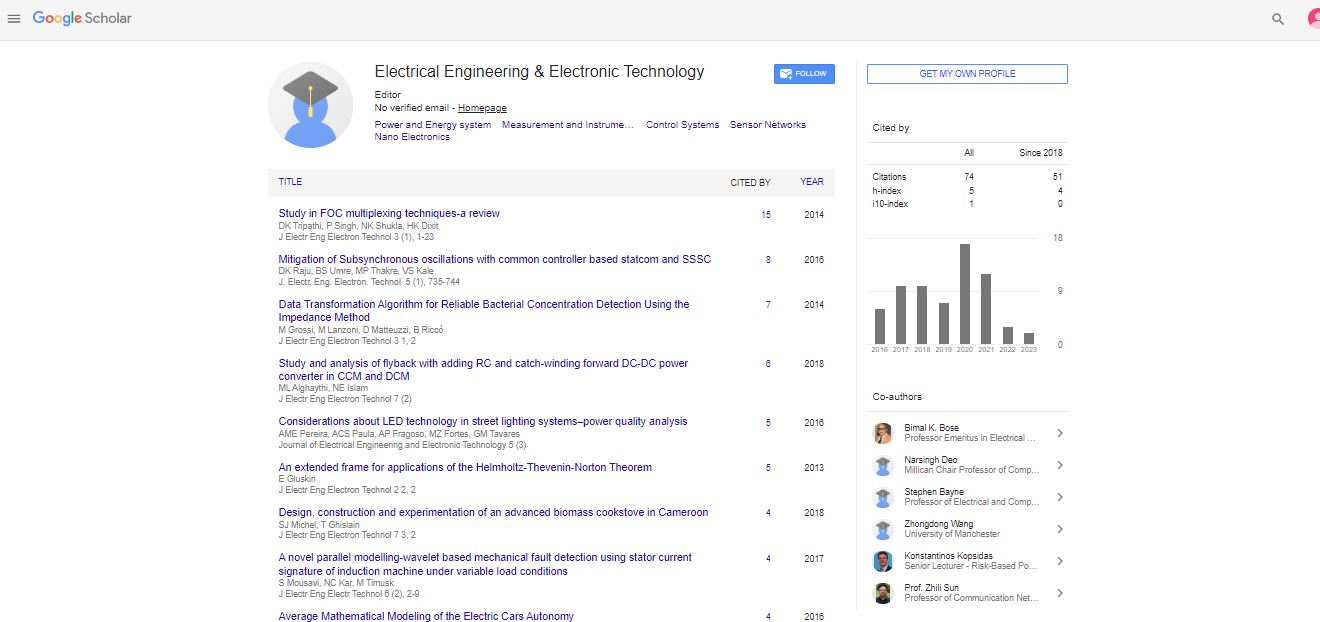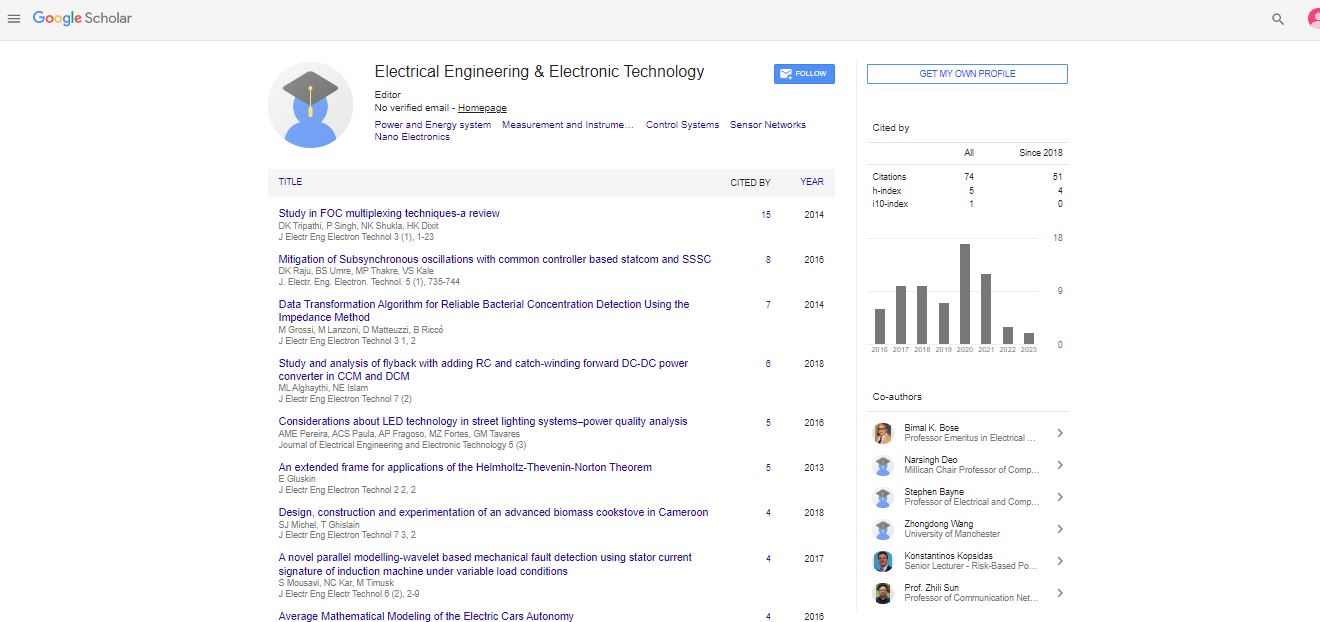Commentary, J Electr Eng Electron Technol Vol: 11 Issue: 8
Design and Simulation of a Destruction Mechanism of Transient Electronic Devices
Aruna Smith*
Department of Electrical Engineering, University of Louvain, Louvain, Belgium
*Corresponding Author:Aruna Smith
Department of Electrical Engineering, University of Louvain, Louvain, Belgium
Email: smitharuna@gmail.com
Received date: 11 July, 2022, Manuscript No. JEEET-22-54787;
Editor assigned date: 13 July, 2022; PreQC No. JEEET-22-54787 (PQ);
Reviewed date: 15 July, 2022, QC No. JEEET-22-54787;
Revised date: 18 August, 2022, Manuscript No. JEEET-22-54787 (R);
Published date: 24 August, 2022, DOI: 10.4172/jeeet.1000924.
Citation: Smith A (2022) Design and Simulation of a Destruction Mechanism of Transient Electronic Devices. J Electr Eng Electron Technol 11:08
Keywords: Biodegradable materials
Description
To quickly destroy electronic devices and ensure information security, a destruction mechanism of transient electronic devices was designed. By placing the Ni-Cr film resistance and the energetic material between the chip and the package and heating the resistance by an electric current, the energetic material expanded and the chip cracked. The information on the chip was destroyed. The author simulated the temperature distribution and stress of the power-on structure in different sizes by ANSYS software. The simulation results indicate that the chip cracks within 50 ms under the trigger current of 0.5 a when a circular groove with an area of 1 mm2 and depth of 0.1 mm is filled with an expansion material. The simulation and experimental results confirm the feasibility of the structure in quick destruction, which lays the foundation for developing instantaneous failure integrated circuit products to meet information security applications. With the rapid development of semiconductor technology, electronic technology has brought unparalleled convenience to people’s life by accelerating and improving the acquisition, storage and transmission of information. As physical carriers of information and technology, electronic components are related to the security of core information and key technologies of military equipment and are the hard power to guarantee the security of the fifth territory cyberspace, after land, sea, air, and sky. Traditionally, the core electronic components are destroyed by high-pressure burning, quick wiping or encryption algorithm method to ensure information security. However, for the high-pressure burning method, there is a hidden danger of incomplete damage to core components; for the quick erasing method, the information may be recovered because of incomplete erasing; for the encryption algorithm method, as the algorithm and other core technical information are stored in the physical carrier of equipment, security problems may occur at the device level.
Transient Electronic Technology
There are some unavoidable and difficult technical obstacles for the transient electronic technology based on degradation and disappearance in practical application, including the following aspects first, the introduction of biodegradable materials makes the packaging and structure of devices different from that of conventional electronic devices fundamentally, which is difficult to meet the requirements of conventional electronic devices, especially for military electronic devices that are resistant to high temperature, cold, acid, and alkali and even radiation and other harsh application environments; second, a transient electronic device should be equipped with ultrathin core part and even must adopt such device types as thin-film electronic and organic electronic, which restricts the applicable scene of transient electronic devices seriously and makes them difficult to meet the application requirements such as high power and large driving ability; last, it is difficult to reconcile the contradiction between the long-time stability and fast degradation of transient electronic devices, which greatly limits the reliability of transient electronic devices. In order to solve the problems of transient electronic devices that can degrade and disappear themselves and thus expand their scope of application, in this paper, a destruction mechanism to rapidly crack integrated circuit chip by using instantaneous expansion stress was proposed, which can be applied in the field of information security to reduce the risk of information theft and ensure information security. The conventional package structure was adopted in the scheme and the energetic material was filled between the chip and the package. The power-on ignition bridge resistance was used to rise temperature rapidly and trigger the cascade reaction of energetic materials to cause gas instantaneous expansion and stress release. The chip cracked under the pressure of gas expansion. This information destruction method can eliminate the unrecoverable information almost instantaneously, which has greatly improved the security of information. Researchers have done a lot of research studies on the materials, preparation technology and triggering mechanism of transient electronics. The materials of transient electronic devices can be divided into substrate materials, dielectric materials, interconnection conductor materials and functional materials. Silk, cellulose and some high polymer materials have been proved to be suitable for the preparation of transient electronic devices. For example, silk has been used as substrate material and packaging material for a variety of transient electronic devices such as high-performance transistors, remote control devices and biodegradable batteries. The degradation rate of the silk can be adjusted from a few minutes to several years by adjusting the crystallinity of the silk. Cellulose is soluble because it contains linear glucose chains. Cellulose and its derivatives have been widely used in printing electronics, paper-based electronics, and Nano sensors. Degradable polymers such as polyvinyl alcohol, polyvinylpyrrolidone, polylactic acid, polyglycolic acid, polycaprolactone and polyhydroxybutyrate are also suitable for use as degradable substrates.
Encapsulation Process
At present, the preparation technologies of transient electronic devices mainly include vacuum-based mask deposition, transfer printing, and inkjet printing. In vacuum-based mask deposition, a thin line mask is made by cutting or etching polyimide films and attached to the substrate for selective material deposition. However, the use of shadow masks does not allow feature sizes below a few micrometers, resulting in limited resolution of the deposited material. Therefore, vacuum-based mask deposition is not applicable to complex circuits. To address the above mentioned application limitations of vacuum based mask deposition technology, transfer printing technology emerged as a new alternative. Transfer printing refers to the technology of transferring processed and integrated materials from one substrate to another. The device is prepared temporarily on a conventional substrate such as a silicon wafer by a standard IC process and then transferred to a degradable substrate using a sacrificial layer. It expands the range of machined substrates by isolating the harsh conditions of IC manufacturing processes (such as heating and etching) from the target substrates. Inkjet printing involves two steps: printing and sintering. First, the required graphics and components are printed on the substrate through modern printing technology. Then the printed micro/nanoparticles are tightly bonded together through sintering to maintain electrical continuity and improve electrical conductivity. The sintering process is usually carried out by heating, which is not practical for degradable materials in most cases. In order to avoid thermal damage of printing particles during sintering, local heating methods such as photonic sintering, laser sintering, and other high-energy beams can be adopted. Sintering can also be achieved by electrochemical method at room temperature, which can completely prevent overheating impact. Inkjet printing technology is a promising light manufacturing technology, which can achieve printing at room temperature and pressure and thus greatly reduce the production cost. The technology is suitable for both organic and inorganic materials such as mixed ink, glass, chip, paper, and plastic and can be used as an alternative to standard vacuum deposition and lithography. The instantaneous chip cracking structure was considered with the compatibility of trigger mode, material, and encapsulation process. The traditional materials and packaging were used as much as possible to reduce problems in processing and use. The substrate and the device were made of traditional monocrystalline silicon that was the best material choice because many problems of instantaneous degradation materials have not been solved. The ignition bridge was made of NiCr alloy film because of its stable performance, high resistivity, excellent heating effect, strong adhesion, and easy preparation, and it can be directly integrated with silicon. It can produce instantaneous high temperature above 600°C after it was powered on to provide initial conditions for the cascade reaction of energetic materials. The energetic material was composed of CuO and Al particles with diameters have common packaging materials include metals, ceramics, and plastics. The package shell was made of ceramics that can withstand high temperature with lower thermal conductivity than metals, which contributed to the instantaneous high temperature inside the package shell and the transient failure of the chip. The temperature required to destroy the chip of the circular groove structure was slightly lower than that of the square groove structure when the heights and surface areas of the grooves were the same. But shape was not the main factor affecting the cracking effect. The temperature decreased with the increase of groove depth when the shapes and surface areas of grooves were the same. Different depths had an obvious influence on the cracking effect. The temperature decreased first and then increased with the increase of groove area. The temperature decreased due to the expansion force gathering in the center breakthrough, and the increase in the volume of the expansion material resulted in a better cracking effect when the groove area was small. However, when the groove area increased to a certain extent, the surface of the expanding material expanded more evenly, the stress concentrated more obviously at the edge of the groove, which dispersed part of the expansion force, and thus, the chip would crack at higher temperatures.
 Spanish
Spanish  Chinese
Chinese  Russian
Russian  German
German  French
French  Japanese
Japanese  Portuguese
Portuguese  Hindi
Hindi 
